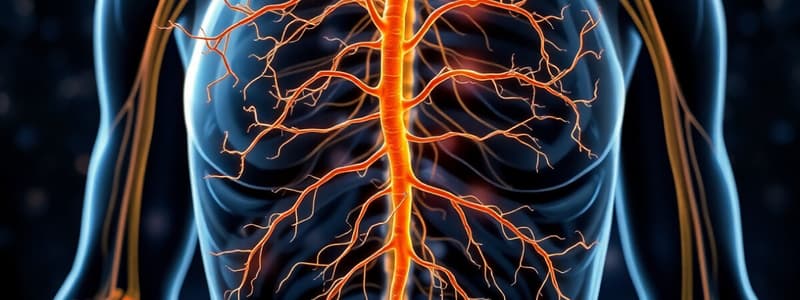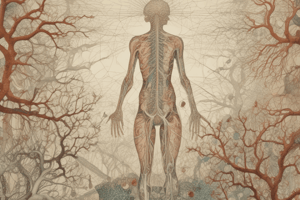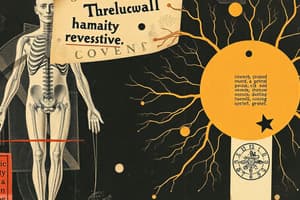Podcast
Questions and Answers
What is the primary function of the autonomic nervous system (ANS)?
What is the primary function of the autonomic nervous system (ANS)?
The ANS coordinates the automatic control of all visceral organs.
Explain the significance of the dual neuron arrangement in the control of visceral motor functions.
Explain the significance of the dual neuron arrangement in the control of visceral motor functions.
The dual neuron arrangement allows for a two-step signal transmission from the CNS to the target organ, enhancing control and responsiveness.
Differentiate between the sympathetic and parasympathetic divisions of the ANS.
Differentiate between the sympathetic and parasympathetic divisions of the ANS.
The sympathetic division is responsible for the 'fight or flight' response, while the parasympathetic division promotes 'rest and digest' functions.
Identify the types of muscles and glands that the ANS primarily affects.
Identify the types of muscles and glands that the ANS primarily affects.
What are the roles of the afferent and efferent divisions in the peripheral nervous system (PNS)?
What are the roles of the afferent and efferent divisions in the peripheral nervous system (PNS)?
Describe the location of the synapse for the preganglionic neuron in the sympathetic division.
Describe the location of the synapse for the preganglionic neuron in the sympathetic division.
What are the lengths of the preganglionic and postganglionic neurons in the parasympathetic division?
What are the lengths of the preganglionic and postganglionic neurons in the parasympathetic division?
Where do the preganglionic neurons of the sympathetic division project from?
Where do the preganglionic neurons of the sympathetic division project from?
What is the role of the vagus nerve in the autonomic nervous system?
What is the role of the vagus nerve in the autonomic nervous system?
How does the length of the postganglionic neuron in the sympathetic division compare to that in the parasympathetic division?
How does the length of the postganglionic neuron in the sympathetic division compare to that in the parasympathetic division?
What components make up the Central Nervous System (CNS)?
What components make up the Central Nervous System (CNS)?
What is the role of neurotransmitters in neuron communication?
What is the role of neurotransmitters in neuron communication?
What are the two main divisions of the Peripheral Nervous System (PNS)?
What are the two main divisions of the Peripheral Nervous System (PNS)?
What happens during the process of depolarization in neurons?
What happens during the process of depolarization in neurons?
What distinguishes the Autonomic Nervous System from the Somatic Nervous System?
What distinguishes the Autonomic Nervous System from the Somatic Nervous System?
What initiates the process of communication between neurons?
What initiates the process of communication between neurons?
What are the two primary divisions of the autonomic nervous system?
What are the two primary divisions of the autonomic nervous system?
Name one sympathomimetic drug and its primary action.
Name one sympathomimetic drug and its primary action.
What is the role of acetylcholine in the autonomic nervous system?
What is the role of acetylcholine in the autonomic nervous system?
What type of drug is atropine classified as, and what is its effect?
What type of drug is atropine classified as, and what is its effect?
Give an example of a drug that can act as a parasympathomimetic.
Give an example of a drug that can act as a parasympathomimetic.
What neurotransmitter is primarily associated with the sympathetic nervous system?
What neurotransmitter is primarily associated with the sympathetic nervous system?
What is the significance of drugs like propranolol in the context of the autonomic nervous system?
What is the significance of drugs like propranolol in the context of the autonomic nervous system?
What neurotransmitter is involved in increasing heart rate through sympathetic innervation?
What neurotransmitter is involved in increasing heart rate through sympathetic innervation?
How does acetylcholine affect heart rate via the parasympathetic nervous system?
How does acetylcholine affect heart rate via the parasympathetic nervous system?
What is the mechanism by which atropine can increase heart rate in emergency situations?
What is the mechanism by which atropine can increase heart rate in emergency situations?
Define parasympatholytic drugs and their primary effect.
Define parasympatholytic drugs and their primary effect.
What class of drugs would stimulate sympathetic nerves to increase heart rate?
What class of drugs would stimulate sympathetic nerves to increase heart rate?
What is the impact of drugs classified as sympatholytic?
What is the impact of drugs classified as sympatholytic?
Name a drug that blocks the reuptake of norepinephrine (NA) and describe its action.
Name a drug that blocks the reuptake of norepinephrine (NA) and describe its action.
What distinguishes parasympathomimetic drugs from sympathomimetic drugs?
What distinguishes parasympathomimetic drugs from sympathomimetic drugs?
What are the two main neurotransmitters involved in neuronal synaptic transmission of the autonomic nervous system?
What are the two main neurotransmitters involved in neuronal synaptic transmission of the autonomic nervous system?
What type of receptors does noradrenaline bind to in the autonomic nervous system?
What type of receptors does noradrenaline bind to in the autonomic nervous system?
What type of receptors does acetylcholine bind to, and how are they categorized?
What type of receptors does acetylcholine bind to, and how are they categorized?
What is the primary neurotransmitter released by postganglionic neurons in the sympathetic division, and what is the exception for sweat glands?
What is the primary neurotransmitter released by postganglionic neurons in the sympathetic division, and what is the exception for sweat glands?
Identify the type of receptor associated with preganglionic neurons in the autonomic nervous system and its neurotransmitter.
Identify the type of receptor associated with preganglionic neurons in the autonomic nervous system and its neurotransmitter.
How does the autonomic nervous system influence heart rate and other visceral organs?
How does the autonomic nervous system influence heart rate and other visceral organs?
Flashcards
What is the autonomic nervous system (ANS)?
What is the autonomic nervous system (ANS)?
The autonomic nervous system (ANS) controls involuntary bodily functions like heart rate, breathing, digestion, and sweating.
How does the ANS differ from the somatic nervous system?
How does the ANS differ from the somatic nervous system?
The ANS operates independently of conscious control, unlike the somatic nervous system which controls voluntary movements.
What are the two branches of the ANS and their roles?
What are the two branches of the ANS and their roles?
The ANS is divided into two branches: the sympathetic and parasympathetic nervous systems, which have opposing effects to maintain homeostasis.
What does the sympathetic nervous system do?
What does the sympathetic nervous system do?
Signup and view all the flashcards
What does the parasympathetic nervous system do?
What does the parasympathetic nervous system do?
Signup and view all the flashcards
What is the nervous system?
What is the nervous system?
Signup and view all the flashcards
What parts make up the Central Nervous System?
What parts make up the Central Nervous System?
Signup and view all the flashcards
What is the Peripheral Nervous System (PNS)?
What is the Peripheral Nervous System (PNS)?
Signup and view all the flashcards
What is the Sympathetic Nervous System?
What is the Sympathetic Nervous System?
Signup and view all the flashcards
What is the Parasympathetic Nervous System?
What is the Parasympathetic Nervous System?
Signup and view all the flashcards
What are neurotransmitters?
What are neurotransmitters?
Signup and view all the flashcards
How can drugs affect the nervous system?
How can drugs affect the nervous system?
Signup and view all the flashcards
What are ganglia in the ANS?
What are ganglia in the ANS?
Signup and view all the flashcards
What does the ANS control?
What does the ANS control?
Signup and view all the flashcards
Describe the lengths of neurons in the sympathetic division.
Describe the lengths of neurons in the sympathetic division.
Signup and view all the flashcards
Describe the lengths of neurons in the parasympathetic division.
Describe the lengths of neurons in the parasympathetic division.
Signup and view all the flashcards
What is the vagus nerve?
What is the vagus nerve?
Signup and view all the flashcards
What is the sympathetic trunk?
What is the sympathetic trunk?
Signup and view all the flashcards
How does noradrenaline affect heart rate?
How does noradrenaline affect heart rate?
Signup and view all the flashcards
How does acetylcholine affect heart rate?
How does acetylcholine affect heart rate?
Signup and view all the flashcards
How do mAChR blockers affect heart rate?
How do mAChR blockers affect heart rate?
Signup and view all the flashcards
How do drugs affect the ANS?
How do drugs affect the ANS?
Signup and view all the flashcards
What are the different types of ANS drugs?
What are the different types of ANS drugs?
Signup and view all the flashcards
What are the two branches of the ANS?
What are the two branches of the ANS?
Signup and view all the flashcards
What are the main neurotransmitters in the ANS?
What are the main neurotransmitters in the ANS?
Signup and view all the flashcards
What are agonists and antagonists?
What are agonists and antagonists?
Signup and view all the flashcards
How do sympathomimetics and sympatholytics work?
How do sympathomimetics and sympatholytics work?
Signup and view all the flashcards
What are the key neurotransmitters in the ANS?
What are the key neurotransmitters in the ANS?
Signup and view all the flashcards
What type of receptors does noradrenaline bind to?
What type of receptors does noradrenaline bind to?
Signup and view all the flashcards
What type of receptors does acetylcholine bind to?
What type of receptors does acetylcholine bind to?
Signup and view all the flashcards
How does communication occur between preganglionic and postganglionic neurons?
How does communication occur between preganglionic and postganglionic neurons?
Signup and view all the flashcards
What neurotransmitters are released by postganglionic neurons?
What neurotransmitters are released by postganglionic neurons?
Signup and view all the flashcards
What is the role of the sympathetic nervous system?
What is the role of the sympathetic nervous system?
Signup and view all the flashcards
What is the role of the parasympathetic nervous system?
What is the role of the parasympathetic nervous system?
Signup and view all the flashcards
How can pharmacological intervention affect the ANS?
How can pharmacological intervention affect the ANS?
Signup and view all the flashcards
Study Notes
Autonomic Nervous System (ANS)
- The ANS is a complex network of nerves and cells that carry messages to and from the brain and spinal cord to various parts of the body.
- It's part of the peripheral nervous system (PNS).
- The PNS includes the somatic division, controlling voluntary actions, and the autonomic division, managing involuntary processes such as heart rate and digestion.
- The ANS is further divided into sympathetic and parasympathetic branches, which often have opposing effects.
ANS Structure and Function
- The ANS coordinates involuntary actions, such as heart rate regulation and digestion.
- The ANS network involves a series of interconnected neurons that carry signals from the CNS to target organs or muscles.
- Neurons in the ANS communicate using charged ions to create a current and a specialized biochemical bridge called a synapse.
Neuron Communication
- Neurons communicate through a process involving depolarization followed by the release of neurotransmitters.
- Neurotransmitters cause depolarization in the next neuron, carrying the signal.
- Drugs acting on neurotransmitters can influence ANS activity.
- The ANS uses two primary neurotransmitters—noradrenaline and acetylcholine.
ANS Divisions
- Sympathetic Division (fight-or-flight): Prepares the body for action by increasing heart rate, blood pressure, and respiration. Its preganglionic neurons are short, and postganglionic neurons are long.
- Parasympathetic Division (rest-and-digest): Promotes rest and digestion by slowing heart rate, lowering blood pressure, and increasing digestion. Its preganglionic neurons are long, and postganglionic neurons are short.
Neurotransmitters and Receptors
- The neurons involved in the ANS use neurotransmitters (like noradrenaline and acetylcholine).
- The neurotransmitters bind to specific receptors on target organs and cells.
- Adrenergic receptors respond to noradrenaline, and cholinergic receptors respond to acetylcholine.
- Different types of receptors (e.g., muscarinic and nicotinic) respond to acetylcholine in different ways.
Drug Effects on the ANS
- Drugs can alter ANS activity by targeting neurotransmitters and receptors.
- Some drugs mimic or block neurotransmitters' effects.
- Examples include drugs used to increase or decrease heart rate.
- Drugs can directly affect receptors in the target organ or the neurons themselves within ganglia.
- Many drugs that affect the ANS operate by either blocking or stimulating specific receptors.
ANS (Example - Heart)
- The sympathetic nervous system increases heart rate via noradrenaline acting on β-adrenergic receptors.
- The parasympathetic nervous system decreases heart rate via acetylcholine acting on muscarinic cholinergic receptors.
ANS (Drugs)
- Drugs affecting the ANS can be categorized to help understand their effects.
- Drugs might inhibit or stimulate either sympathetic or parasympathetic actions. These drugs target either ganglia or target organs.
- Drugs can block or mimic neurotransmitter actions such as acetylcholine, and noradrenaline to affect visceral activity.
ANS (Preganglionic neurons)
- The preganglionic neurons originate in the central nervous system (CNS).
- The neurons extend to ganglions (clusters of nerve cells) in the autonomic nervous system.
- The sympathetic division originates primarily from the thoracic and lumbar regions of the spinal cord; the parasympathetic originates from the cranial and sacral regions.
ANS (The Vagus Nerve)
- The vagus nerve (cranial nerve X) is a major cranial nerve involved in parasympathetic activity.
- It controls various organ systems like the heart, lungs, and digestive tract.
- The vagus nerve has many branches, which affect different tissues and organs all along the path.
- The vagus primarily controls parasympathetic activity in visceral organs with its extensive branching.
Studying That Suits You
Use AI to generate personalized quizzes and flashcards to suit your learning preferences.
Related Documents
Description
Dive into the fascinating world of the Autonomic Nervous System (ANS) and discover its vital role in regulating involuntary actions like heart rate and digestion. This quiz explores the structure, function, and communication processes of neurons within the ANS, highlighting its divisions and interactions. Test your knowledge and deepen your understanding of this essential part of the peripheral nervous system.




